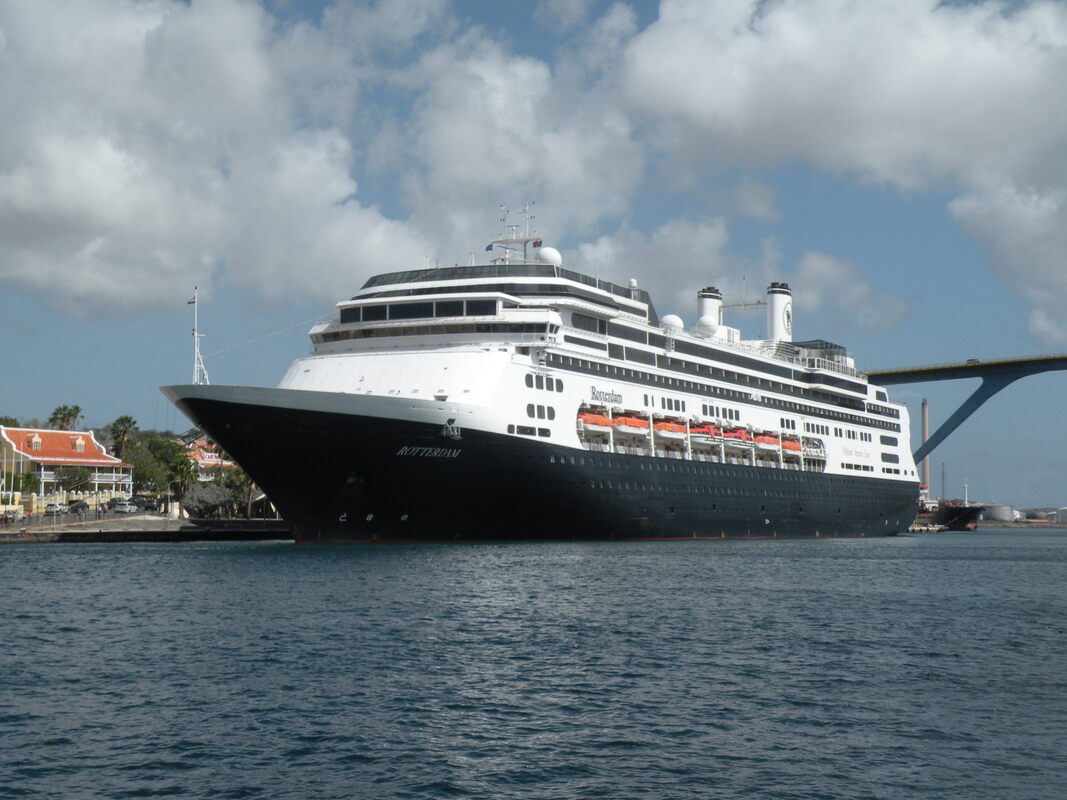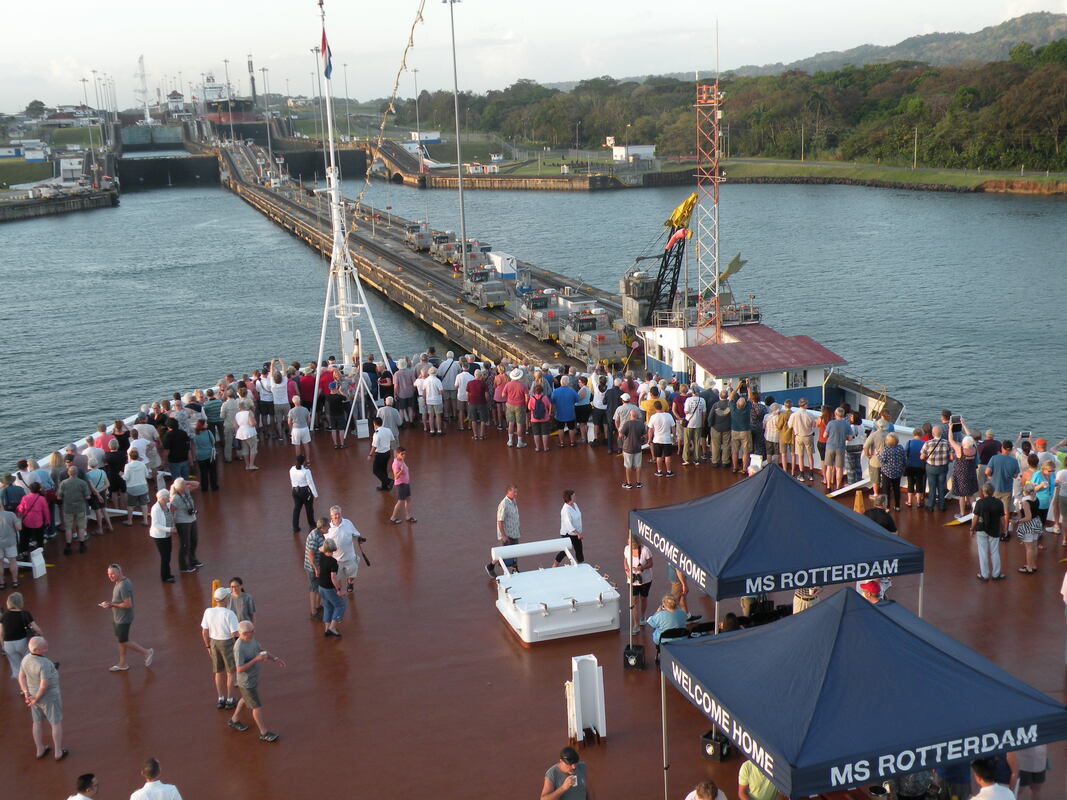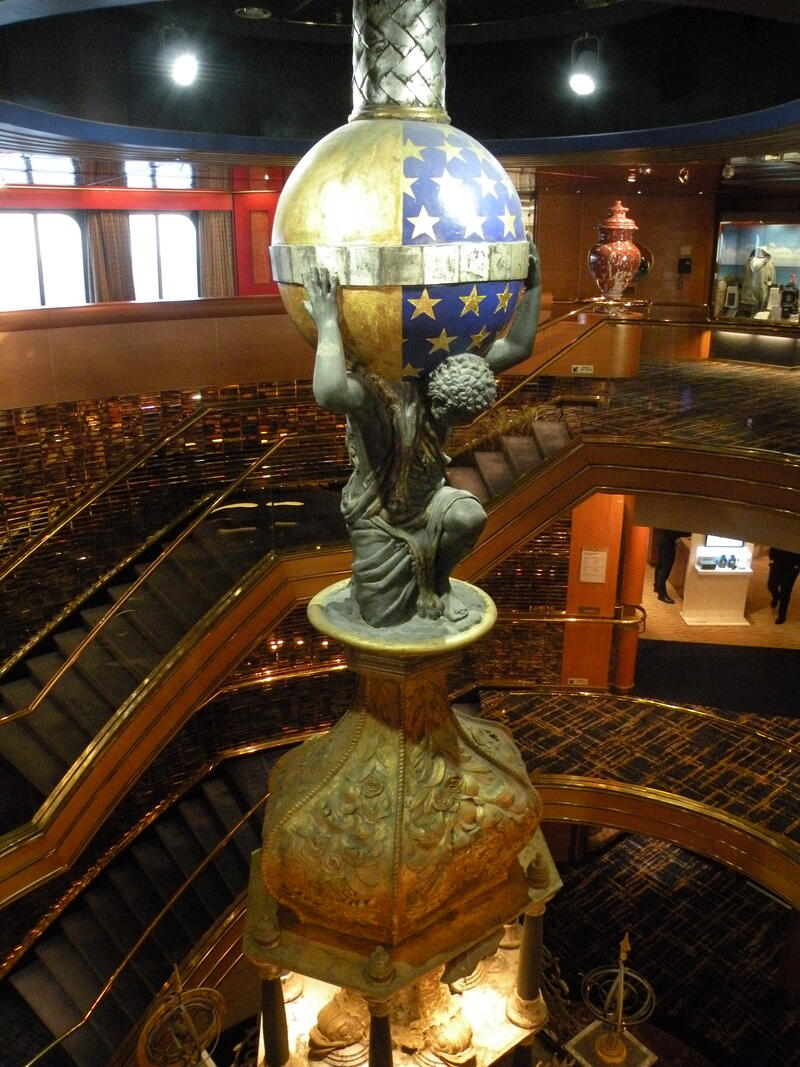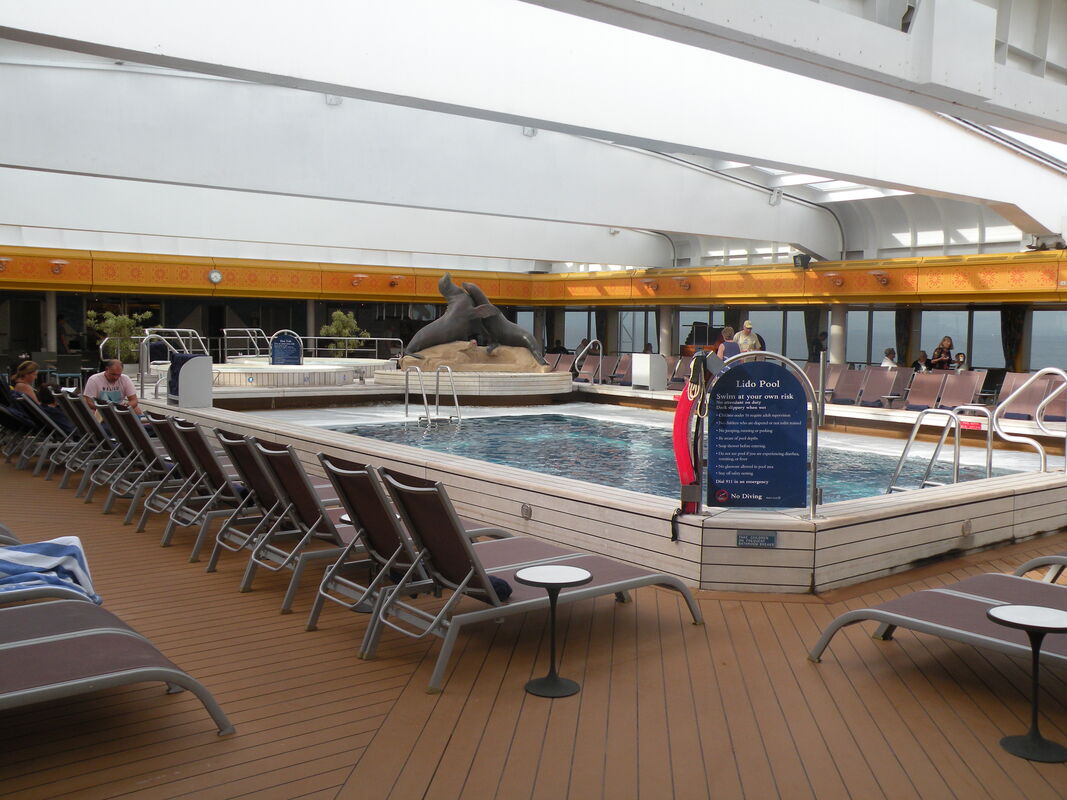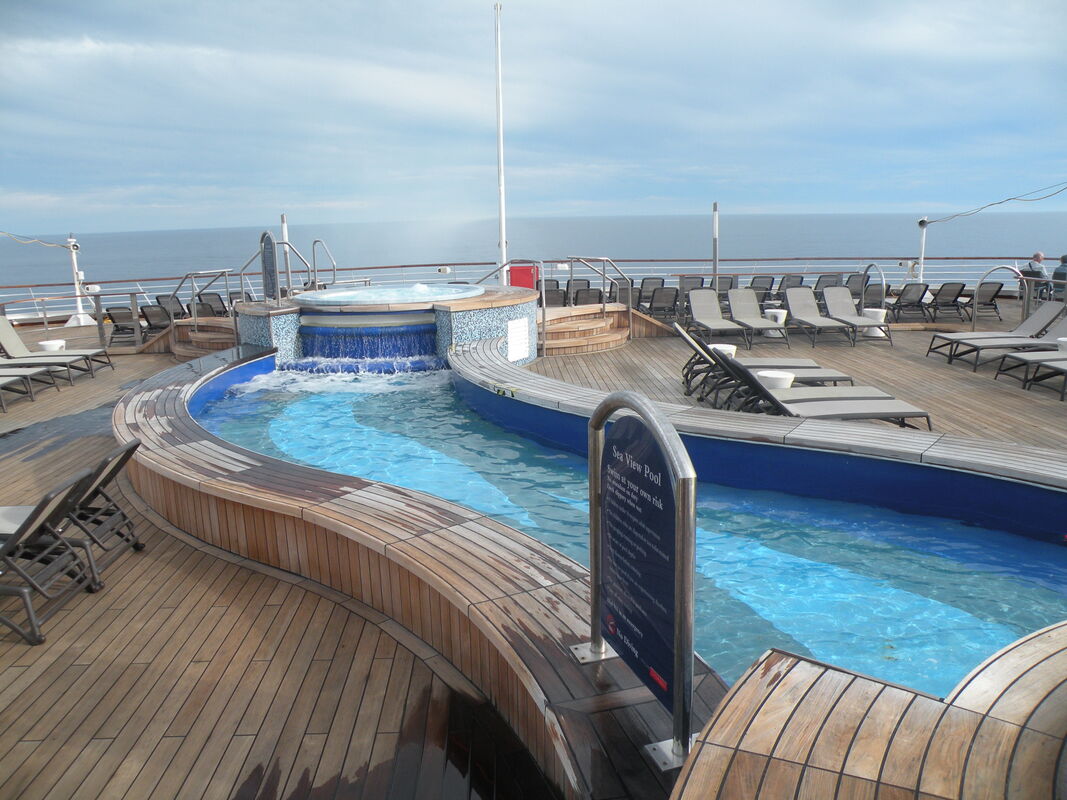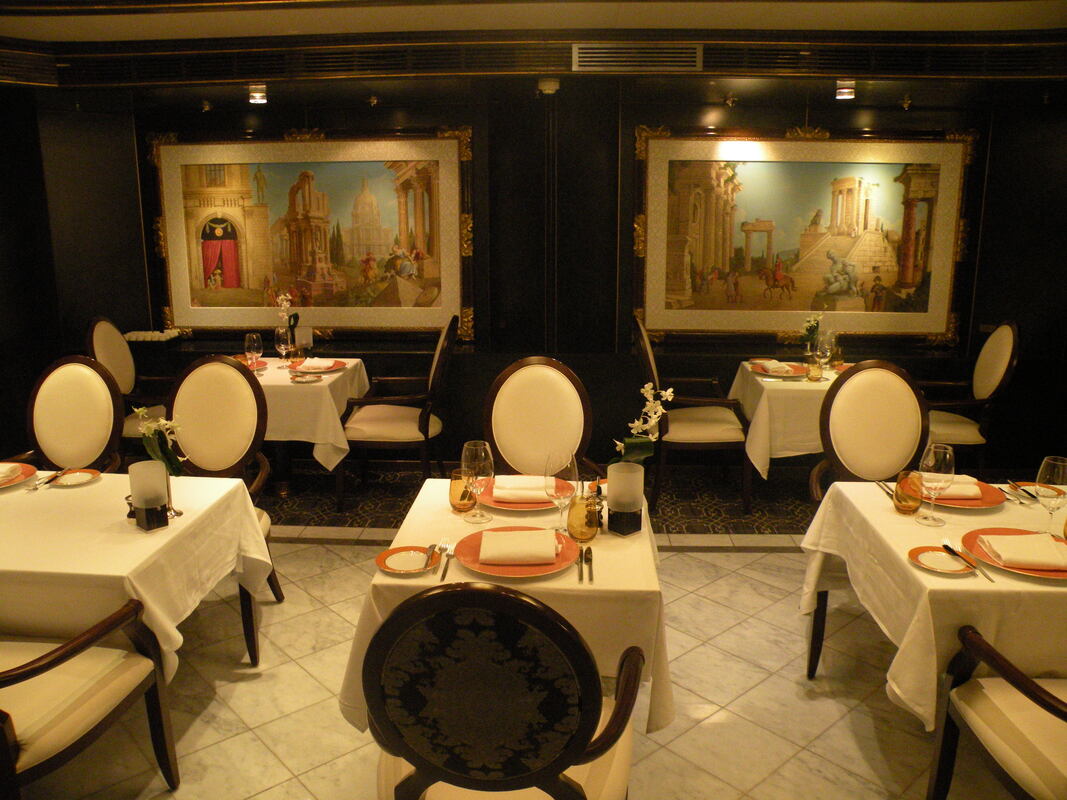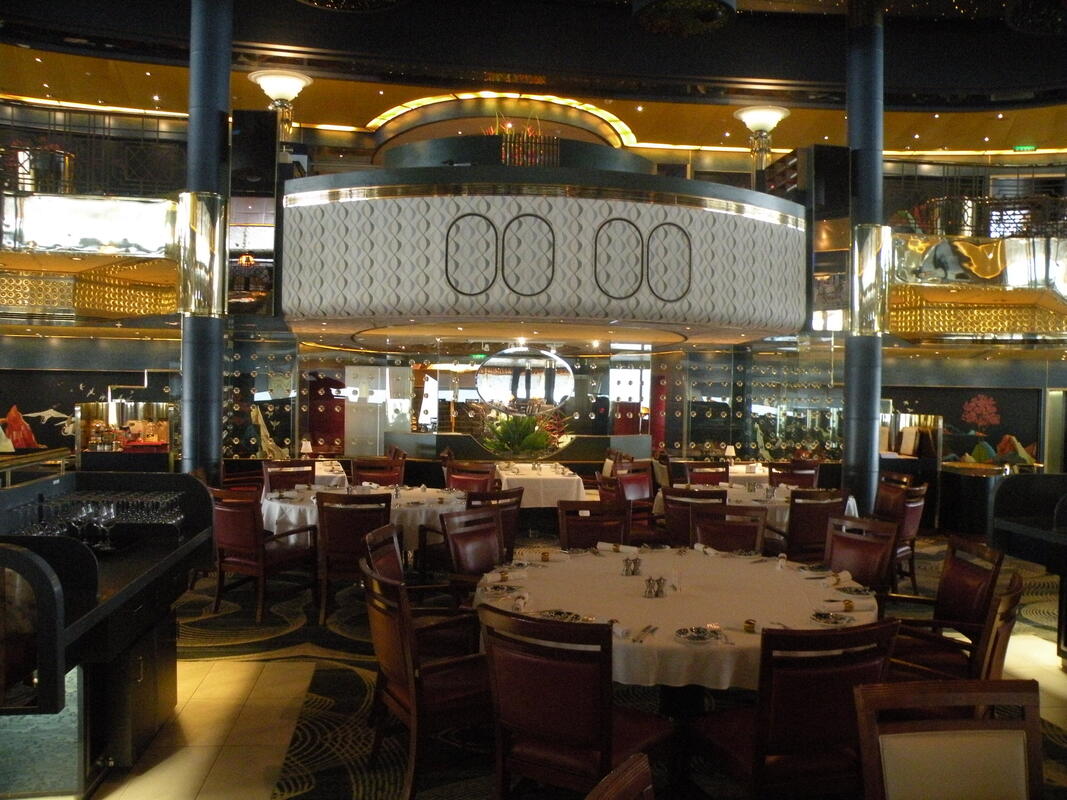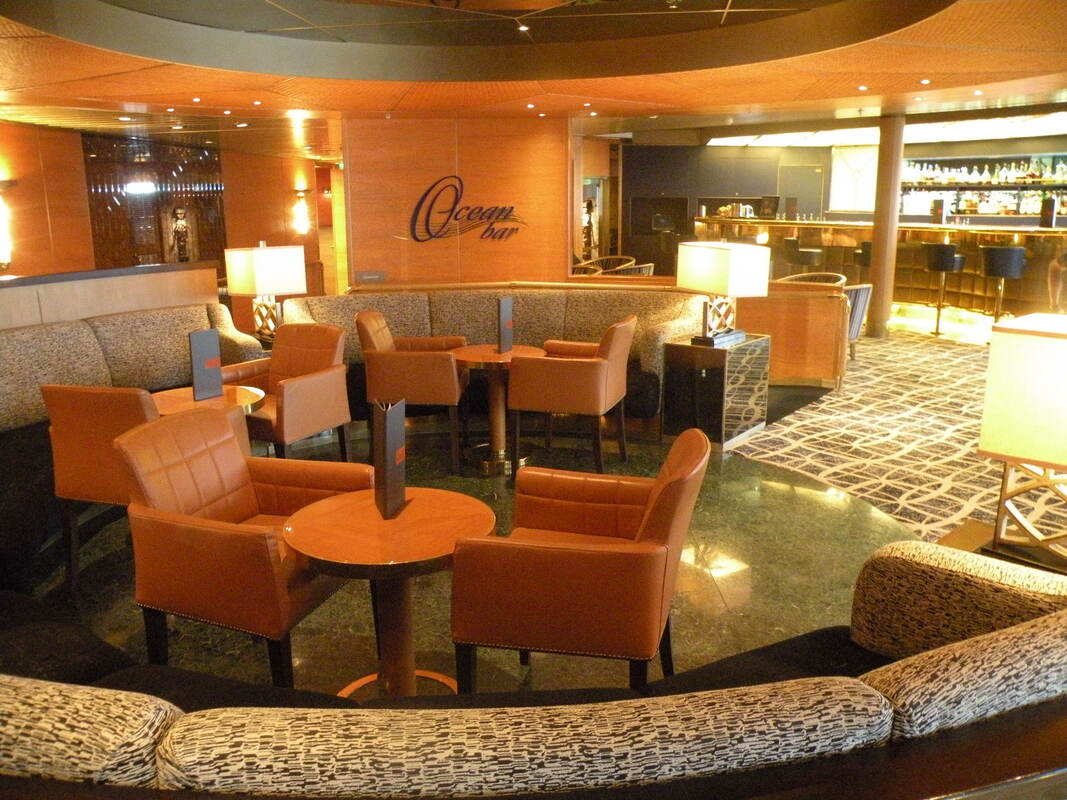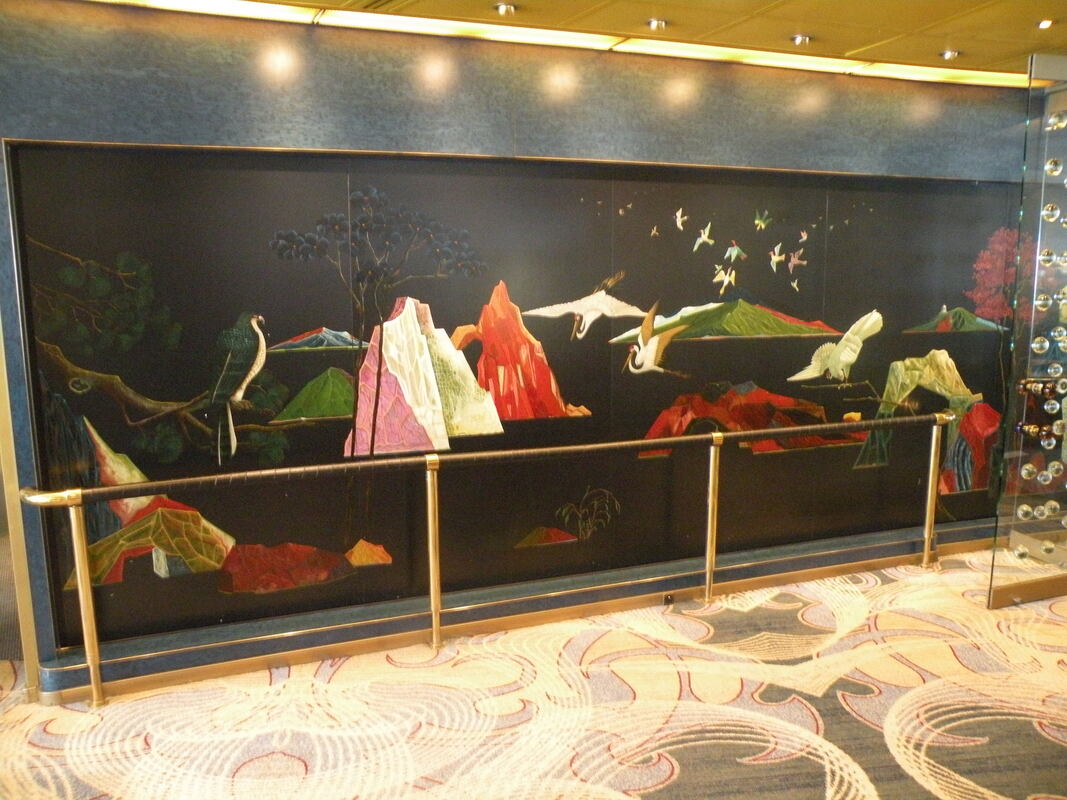|
For a long-anticipated transit of the Panama Canal, we booked a sixteen-night cruise on Holland America Line’s Rotterdam commencing on February 24 from Fort Lauderdale. This cruise had scheduled port calls at Willemstad in Curacao, Oranjestad in Aruba, Puerto Caldera in Costa Rica, Corinto in Nicaragua, Puerto Quetzal in Guatemala, and Huatalco and Puerto Vallarta in Mexico before arriving in San Diego on March 11. Because of a severe storm along the west coast of Mexico, the ship was diverted from Huatalco to Manzanillo, but otherwise the cruise went as scheduled.
The ship The Rotterdam was built by Fincantieri in Trieste and entered service in 1997, the same year that its predecessor, Rotterdam (V) dating from 1959, was sold to Premier Cruise Line to become the Rembrandt. The Rotterdam was the first of four ships in the R Class, the others being the Volendam, Zaandam and Amsterdam. The Rotterdam and Amsterdam are sister ships. Each has two funnels situated side by side rather than fore and aft, an arrangement which mirrors that of Rotterdam (V). The Volendam and Zaandam have only one funnel. The Rotterdam is 781 feet in length and has a beam or width of 106 feet. The ship has a gross tonnage of 61,849. The ship can accommodate 1,404 passengers. On our cruise, there were about 1,230 passengers and 572 officers and crew. The service speed is 22.5 knots, with a maximum speed of 25 knots. During our cruise, we covered 5,050 miles at an average speed of 17 knots, but we traveled at 19-22 knots over many long stretches of the voyage. The bridge of the ship is located on Navigation Deck (Deck 7). On our cruise, the Captain was Bas van Dreumel and the Staff Captain was Harm-Jan Arnold. The Hotel Director was Bert van Meckelenbergh and the Cruise director was Tia Conley. Most of the public rooms on the ship are located on Decks 4, 5, 8 and 9. Passenger cabins are located on Decks 1, 2, 3, 6 and 7. A wraparound promenade is located on Lower Promenade Deck (Deck 3). Here there are many deck chairs with pads. After the advent of Lanai Cabins, which open up onto the promenade, most of the deck chairs on the port and starboard sides of the ship are reserved for the use of those passengers in such cabins. As a result, many of the reserved deck chairs go unused for large parts of the day. At the forward end of Deck 4 is the lower level of The Mainstage, the principal theater on the ship. It is used for lectures as well as entertainment. Three shows were presented by Holland America Line’s Step One Dance Company, six dancers performing to preprogramed music and videos. There were also performances by three different comedians, one of whom, Mike Robinson, was a talented ventriloquist. In addition, we had several musical entertainers. The most popular of the musical entertainers was the group Savannah Jack, who sang rock and country hits from the 1950’s through the 1980’s. We had seen them before on another Holland America Line ship and were glad to see them again. Among the highlights of our cruise were three lectures by Captain Albert J. Schoonderbeek. He was a captain on Holland America ships for many years and is now the Fleet Master. In this capacity, he is part of Holland America Cruises’ On Board Team Support Officer Program. He rotates among the ships to help train officers and crew. On our voyage, his lectures were “The History of Cruising”, “Blue Riband: Heyday of the Atlantic” and “The History of Cruising”. He maintains a blog which provides insights from a captain’s point of view on the ports and ships seen during the cruise. His blog can be found at captainalbert.com. Immediately aft of the lower level of The Mainstage is the Photo Gallery and Photo Shop located on the port side. Proceeding further aft brings you to the second level of the Atrium. In this area are the Guest Services desk and the Shore Excursions desk on the starboard side and a small Art Gallery on the port side. The three levels of the Atrium contain a large, ornamental clock tower surmounted by a statue of Atlas holding a globe with blue stars on it. Beyond the Atrium on Deck 4, the Wajang Theater is on the starboard side. This theater holds only about 100 persons and is used for showing movies and special events. On the port side is the entrance to the Pinnacle Grill, an extra-tariff restaurant, where we dined one evening. The lower level of The Dining Room is at the aft end of Deck 4, but one cannot access it except by going down to Deck 3 or up to Deck 5, since the galley occupies the space immediately aft of the Pinnacle Grill. At dinner time, the lower level is used for anytime dining and the upper level is reserved for early and late seatings. We found the food in The Dining Room to be excellent, although we often found the desserts to be overly sweet. On several occasions, we left after we finished the main course and went to the Lido Market for a greater selection of desserts. The coffee served in The Dining Room and the Lido Market was very good, a far cry from our experience aboard the Pacific Princess in November. At the forward end of Deck 5 is the balcony of The Mainstage. Directly aft on the port side is a shop for logo items and a separate shop for liquor and toiletries. On the starboard side is the Ocean Bar, which continues adjacent to the upper level of the Atrium. Beyond the Atrium on the port side is the Casino, while on the starboard side are a jewelry and watch shop and Billboard OnBoard, a mixed-use venue serving as a sports bar in one area and an evening entertainment venue with two pianists playing popular songs. Further aft on the port side of Deck 5 is the Hudson Room, which serves as a card room, and Explorations Café. Explorations serves as a library and specialty coffee bar. It also contains board games and picture puzzles. On each day a different crossword puzzle and Sudoku puzzle were available. Beyond Explorations Café is the Microsoft Studio, where classes on Microsoft software are provided. On the starboard side is the Merebella Luxury Collection of fine jewelry, the Lincoln Center Stage and adjacent Explorer’s Lounge, which provides additional seating for the Lincoln Center Stage, and the King’s Room, a meeting room for small groups. Programs of classical music were presented in the Lincoln Center Stage. At the stern of Deck 5 is the upper level of The Dining Room. Classic Afternoon Tea is served here in the afternoon. Skipping over Decks 6 and 7, which have passenger staterooms, we come to Deck 8. Directly over the bridge is the Fitness Center and the Greenhouse Spa and Salon. Immediately aft are the Lido Pool and Lido Bar, covered by a magrodome, which was partially open during our cruise. Further aft is the Lido Market. A portion of the Lido Market, on the starboard side, is set aside as Canaletto, a specialty Italian restaurant for which a small fee is charged. We thoroughly enjoyed our dinner there. At the stern of Deck 7, New York Pizza is on the port side, where you can get pizza and salad, the Bar at the Retreat is on the starboard side (one of the few places where smoking was allowed) and The Retreat is in the center. The Retreat consists of two hot tubs and a wading pool. The original full-sized pool was removed years ago when extra cabins were added to the stern of Deck 7. At the forward end of Sports Deck (Deck 9) is the Crow’s Nest, a location for sipping cocktails while overlooking the sea and listening to light entertainment. Immediately aft is a small jogging track encircling the magrodome. Further aft are the Sports Courts, one on either side of the funnels, and Club HAL and the Loft, for young passengers. We used the Sports Courts one day. * David G. Hume is past chairman of the World Ship Society PONY Branch, Mr. Hume has been on more than 90 cruises and crossings as well as numerous ship visits."
|
The ports and the Canal
We had two days at sea before arriving at our first port, Willemstad in Curacao. Already in port just outside the town were Royal Caribbean Line’s Explorer Of The Seas and Norwegian Cruise Line’s Norwegian Sky. We sailed through a channel which divides the town. The Queen Emma pontoon bridge over this channel had been swung aside to let us pass. We then proceeded under the Queen Juliana Bridge to the commercial port on the far side. Here we turned around and went back under the bridge and docked in the center of town, a hundred yards from the pedestrian-only pontoon bridge, which by this time had been swung back into place. The commercial buildings lining the channel are painted in bright pastel colors. We used our time to stroll through the streets of the town and visit several stores. Our next port of call was Oranjestad in Aruba. Docked immediately behind us was Oceania Cruises’ Sirena. Here again we elected not to take any of the tours and strolled around town. After leaving Oranjestad, we had another day at sea. I visited Explorations Cafe and found a book to read. In darkness at 5:30 AM the next morning, we started our approach to the Panama Canal. We passed under the Atlantic Bridge. The sun had risen by the time we entered the first of the three Gatun Locks. Directly ahead of us was Wind Star Cruises’ Wind Star. Behind us was a car carrier. We could also see a large container ship heading to the three Agua Clara Locks to the left. The Agua Clara Locks are for Neopanamax ships which exceed the size of the Gatun Locks. The Agua Clara Locks were built for one-way traffic only, so incoming and outgoing ships must take turns. The Gatun Locks provide for two-way traffic, with ships going in each direction. It took us approximately 20 minutes to go through each lock, rather than the usual 10 minutes, because a drought in the peninsula had led to lower water level in Gatun Lake. To save water, rather than filling up the locks from Gatun Lake, the locks were being crossed-filled, with the water in the lock of an outgoing ship being used to fill the lock of an incoming ship. As we went through the Gatun Locks, it was fascinating to watch the electric towing locomotives, known as “mules”, tie up to the ship on each side. Contrary to popular belief, the mules do not pull ships through the locks. Movement through the locks is provided by a ship’s engines. The mules are used for braking control and to keep a ship from hitting the sides of the locks. Mules are not used in the new Neopanamax locks, mules are not used. Tugs are used to guide the ships through these locks. After passing through the three Gatun Locks, we entered Gatun Lake. We sailed through Gatun Lake for about three hours. During the time of our transit in the canal, the foredeck on Deck 4, which is normally closed, was open to passengers, as was the observation deck forward on Deck 6. On the foredeck, passengers were offered Panama rolls and coffee. Soft drinks were also available for purchase. We chose the higher vantage point of Deck 6, where we were also served Panama rolls. After passing Gamboa, we went through the Culebra Cut, formerly known as the Gaillard Cut, and passed by the terraced Gold Hill on the port side. We then sailed under the Centennial Bridge. Next, we entered the Pedro Miguel Lock. On our right, we could see the first of the three Cocoli Locks for the Neopanamax ships. From the Pedro Miguel Lock, we entered Miraflores Lake. A short time later we entered the first of the two Miraflores Locks, which took us to the Gulf of Panama. We then passed under the Bridge of the Americas and into the Pacific Ocean at about 5:00 PM. We had a day at sea after our transit of the Panama Canal, before we arrived at Puerto Caldera in Costa Rica. We had chosen a full-day tour to San Jose to visit the National Theater and the Gold Museum, but this tour was cancelled because not enough people had booked it. As an alternative, we took the free shuttle bus to Puntarenas and walked around this small town. The Seven Seas Splendor was docked at the pier in Puntarenas. The following day we docked in Corinto in Nicaragua. Docked behind us was Seven Seas Splendor. We took a tour to Leon, a Colonial city founded in 1524 by Spanish conquistadors. The city had previously been the capital of Nicaragua for 200 years before Managua became the capital in 1851. The city lies at the base of the Momotombo volcano. Our next port of call was Puerto Quetzal in Guatemala. Across the harbor, we could once again see Seven Seas Splendor. We opted to take a tour of Antigua. We walked around Central Park, saw the nearby Government Palace and the Church and Convent of La Merced. There were many other churches throughout the city, but several had been severely damaged by earthquakes. We also visited the Jade Museum and Factory. From Puerto Quetzal, we were originally scheduled to go to Huatulco in Mexico. However, due to a forecast of gale force winds and waves of up to 24 feet, the captain decided to skip this port of call, go around the storm and head further north to the port of Manzanillo. During our day at sea, we experienced some motion, but nothing significant as we proceeded at 20 knots. Later that night, however, the ship’s speed was cut to 14 knots when we passed through the storm. The ship pitched during this time, but rolled very little. Since our cabin was amid ship, we were spared most of the motion. Since a visit to Manzanillo had not been scheduled, the local authorities visited the ship as soon as we docked to confirm that there were no cases of Coronavirus on board. On the pier, random checks were made of passengers as they made their way into town. This port is highlighted by a large, blue, forty-foot high sculpture of a sailfish. After briefly walking through town, we headed back to the ship. Our final destination in Mexico was Puerto Vallarta. Here we took a walking tour of the town, starting with the Malecon, a street along the waterfront of Banderas Bay. We then walked up a hill to get a vantage point overlooking the entire city. Next, we passed by the former home of Elizabeth Taylor and Richard Burton, which is now a hotel, Casa Kimberly. We then took a bridge over Gringo Gulch and headed back to the waterfront. Along the way we stopped at a jewelry store, where we were offered complimentary tequila drinks. From Puerto Vallarta, we had two days at sea before arriving in San Diego. We cruised along smoothly at 19 to 22 knots. We docked in San Diego as scheduled and, since no one on board had the Coronavirus, we were allowed to disembark without incident. We took a van to the near-by airport and checked in to our Delta flight to New York. The plane left on time with only half the normal capacity of passengers and arrived early at JFK in New York. Above: Guests gather on the bow as Rotterdam enters the Gatun locks.
|
Above: The ship's atrium.
Above: The main pool area.
Below: The aft pool. Above: The Pinnacle Grill.
Below: The main dining room. Above: The Ocean Bar.
Below: Art in the dining room. (See separate article on Rotterdam's art collection). |
Cruise ship review - - Holland America Line - - Rotterdam - - 2020
